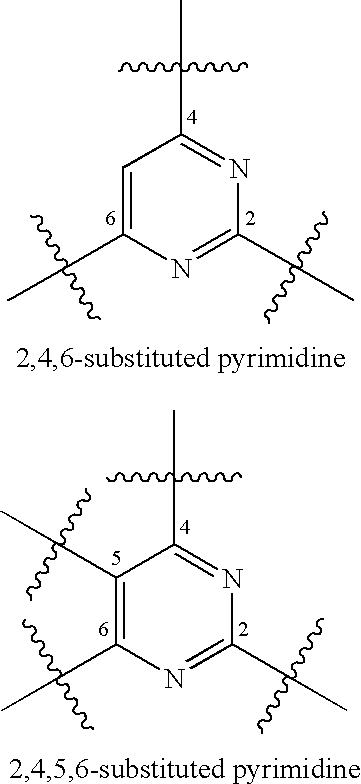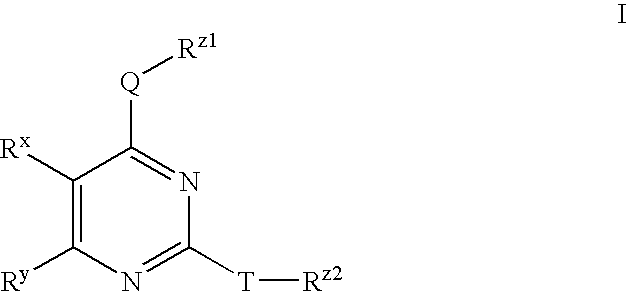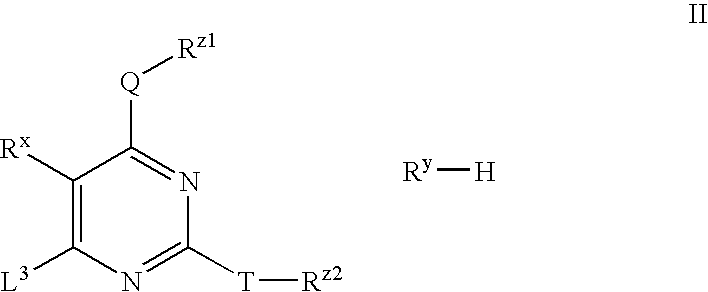Substituted pyrimidines useful as protein kinase inhibitors
a technology of protein kinase inhibitors and substituted pyrimidines, which is applied in the field of preparation of substituted pyrimidines, can solve the problems of reducing the overall yield, cellular proliferation and other abnormalities, and lacking the ability to regioselectively introduce substituents at the 2-, 4- or 6-position in high yields, etc., and achieves low cost, low cost, and easy use.
- Summary
- Abstract
- Description
- Claims
- Application Information
AI Technical Summary
Benefits of technology
Problems solved by technology
Method used
Image
Examples
example 1
[0227]4,6-Dichloropyrimidine-2-methylsulfone (A): Prepared by methods substantially similar to those set forth in Koppell et al, JOC, 26, 1961, 792, in the following manner. To a stirred solution of 4,6-dichloro-2-(methylthio)pyrimidine (50 g, 0.26 mol) in dichloromethane (1 L) at 0° C. was added meta-chloroperoxybenzoic acid (143.6 g, 0.64 mol) over a period of 20 minutes. The solution was allowed to warm to room temperature and was stirred for 4 hours. The mixture was diluted with dichloromethane (1.5 L) and then treated sequentially with 50% Na2S2O3 / NaHCO3 solution (2×200 ml), sat. NaHCO3 solution (4×300 ml), and brine (200 ml) then dried (MgSO4). The solvent was removed in vacuo to afford an off-white solid which was redissolved in EtOAc (1 L) and treated sequentially with sat. NaHCO3 solution (3×300 ml), and brine (100 ml) then dried (MgSO4). The solvent was removed in vacuo to afford the title compound (A) as a white solid (55.6 g, 96% yield). 1H NMR CDCl3 δ 3.40 (3H, s, CH3),...
example 2
[0228]Cyclopropane carboxylic acid [4-(4,6-dichloro-pyrimidin-2-ylsulphanyl)-phenyl]-amide (C): A suspension of compound A (10 g, 44.04 mmol) and cyclopropane carboxylic acid (4-mercapto-phenyl)-amide (B, 8.51 g, 44.04 mmol) in t-butanol (300 ml) was degassed by evacuation, then flushing with nitrogen. The mixture was stirred at 90° C under nitrogen atmosphere for 1 hour then the solvent was removed in vacuo. The residue was dissolved in ethyl acetate (600 ml) and washed with an aqueous solution of potassium carbonate and sodium chloride. The organic extract was dried over magnesium sulphate, concentrated to a low volume and allowed to crystallize. The product C was collected as colourless crystals, (11.15 g, 74%). 1H-NMR DMSO-d6, δ 0.82-0.89 (4H, m), 1.80-1.88 (1H, m), 7.55 (2H, d), 7.70-7.76 (3H, m), 10.49 (1H, s); M+H, 340.
example 3
[0229]Cyclopropane carboxylic acid{4-[4-chloro-6-(5-methyl-2H-pyrazol-3-ylamino)-pyrimidin-2-ylsulphanyl]-phenyl}amide (D): A mixture of compound C (1.0 g, 2.94 mmol)and 3-amino-5-methylpyrazole (314 mg, 3.23 mmol) in dimethylformamide (6 ml) was treated with diisopropylethylamine (0.614 ml, 3.53 mmol) and sodium iodide (530 mg, 3.53 mmol). The mixture was stirred under nitrogen at 85° for 4 hours, cooled to room temperature and diluted with ethyl acetate. The solution was washed with water (×4), dried over magnesium sulphate and concentrated to 5 ml to afford, upon crystallization and harvesting of colourless crystals, the title compound D (920 mg, 78%). 1H-NMR DMSO-d6, δ 0.80-0.87 (4H, m), 1.77-1.85 (1H, m), 1.92 (1H, s), 5.24 (1H, br s), 6.47 (1H, br s), 7.55 (2H, d), 7.70-7.80 (2H, m), 10.24 (1H, s), 10.47 (1H, s), 11.92 (1H, s).
PUM
| Property | Measurement | Unit |
|---|---|---|
| temperature | aaaaa | aaaaa |
| temperature | aaaaa | aaaaa |
| temperature | aaaaa | aaaaa |
Abstract
Description
Claims
Application Information
 Login to View More
Login to View More - R&D
- Intellectual Property
- Life Sciences
- Materials
- Tech Scout
- Unparalleled Data Quality
- Higher Quality Content
- 60% Fewer Hallucinations
Browse by: Latest US Patents, China's latest patents, Technical Efficacy Thesaurus, Application Domain, Technology Topic, Popular Technical Reports.
© 2025 PatSnap. All rights reserved.Legal|Privacy policy|Modern Slavery Act Transparency Statement|Sitemap|About US| Contact US: help@patsnap.com



